A molly fish is a freshwater aquarium fish from the Poeciliidae family. They are popular because of their attractive colors, peaceful temperament, and hardiness. Molly fish come in many varieties, with different sizes and colorations. Depending on the species, they can grow up to 4 inches in length and live for up to 5 years if cared for properly. In addition to being beautiful, they are also easy to care for and require minimal maintenance compared to other types of aquarium fish. Most mollies will eat a variety of food, including flakes, pellets, frozen or freeze-dried foods as well as fresh vegetables such as zucchini or cucumber slices. While not true schooling fish like tetras or barbs, they do appreciate having companionship, so it’s best to keep them in groups of at least three individuals.
13 Types of Molly Fish
Molly fish are a popular choice for aquariums due to their hardiness and peaceful nature. They come in many beautiful colors, sizes, and patterns that make them visually appealing. Additionally, they provide great entertainment as they interact with other fish and explore the tank environment. Molly fish are also easy to care for since they require minimal maintenance and can tolerate a wide range of water conditions. Furthermore, mollies reproduce easily in captivity, so it is possible to increase your stock without needing to purchase new ones! All these qualities combined make molly fish an ideal addition to any home aquarium.
Sailfin Molly
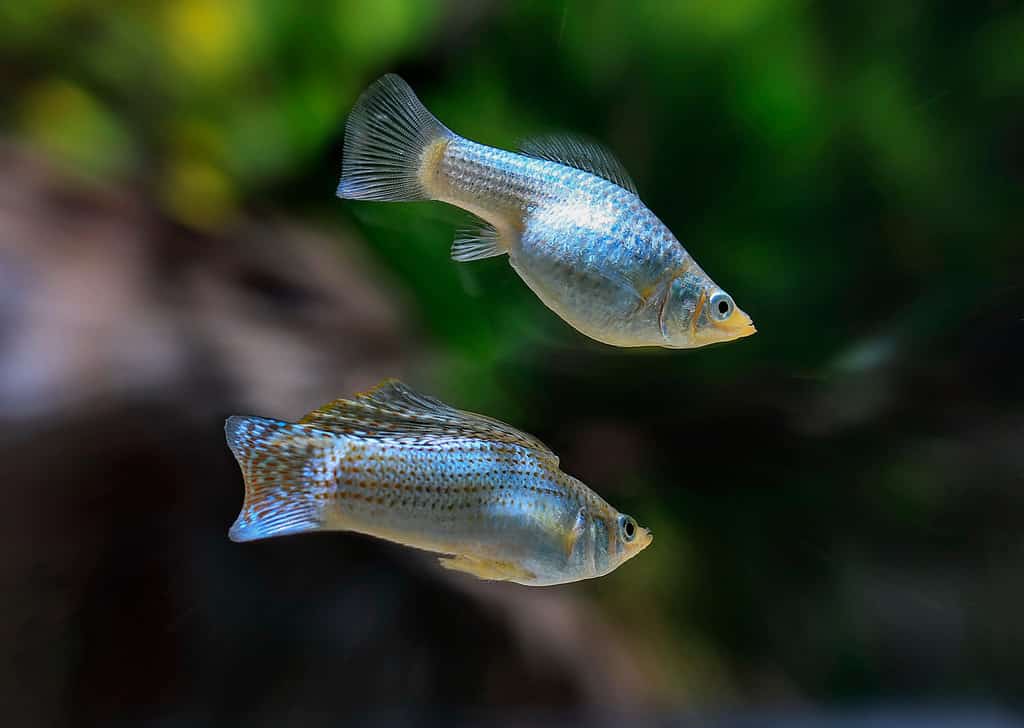
The Sailfin Molly has an elongated body with large fins on its back and sides giving it an impressive sail-like appearance.
©Mr.Sutun photographer/Shutterstock.com
A Sailfin Molly (Poecilia latipinna) is a type of fish that belongs to the family Poeciliidae. It is native to Mexico, Central America, and parts of South America. The Sailfin Molly has an elongated body with large fins on its back and sides giving it an impressive sail-like appearance. Its coloring can vary from light grayish silver with green hues to bright yellow or orange, depending on the species. As far as diet goes, these mollies are omnivorous feeders meaning they will eat both plant matter and small invertebrates such as bugs and worms. They prefer slow-moving waters like ponds or slow-flowing streams where aquatic vegetation grows abundantly, providing them with plenty of food sources.
Costa Rican Molly
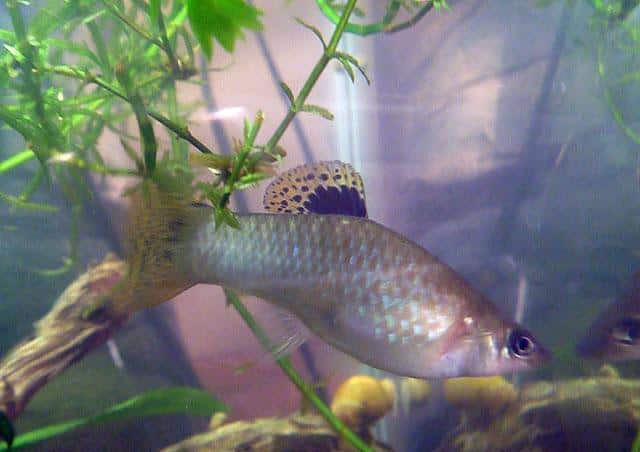
This type of molly is considered to be one of the hardiest species, tolerating a wide range of water conditions and temperatures.
©640 × 452 pixels, file size: 40 KB, MIME type: image/jpeg – License
The Costa Rican molly fish, Poecilia Gillii, is a species of live-bearing freshwater fish that can be found in the coastal regions of Central America. It has an elongated body shape with colors ranging from yellowish to dark brown and black stripes on its back. Its fins are also quite striking – they have bright orange tips! This type of molly is considered to be one of the hardiest species, tolerating a wide range of water conditions and temperatures. They are also known for their peaceful temperament and ability to get along well with other tank mates. When kept in aquariums, these fish do best when given plenty of swimming space and hiding spots among plants or rocks.
Short-Fin Molly
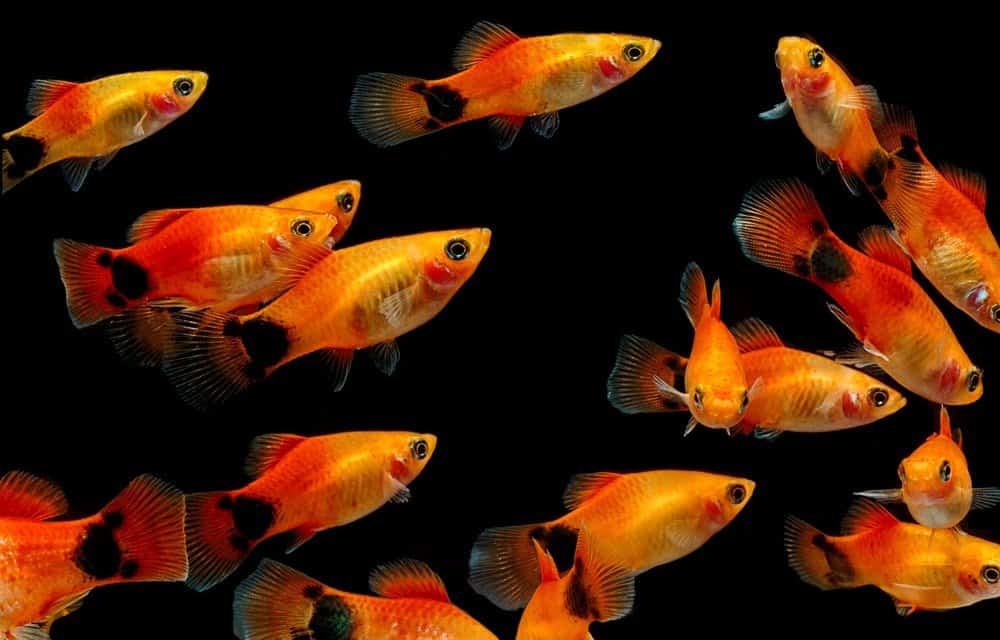
Female short fins tend to be larger than males with more rounded bodies, while males usually have a more slender body shape and longer dorsal fins.
©Praisaeng/Shutterstock.com
Short-fin mollies, also called common molly or Poecilia Sphenops, are a species of small fish native to Mexico and Central America. They have been popular in the aquarium trade for many years due to their hardy nature and peaceful temperament. Short-fin mollies typically reach around 4 inches in length when fully grown and come in a variety of colors, including black, silver, gold, yellow, orange, and even blue. Female short fins tend to be larger than males with more rounded bodies, while males usually have a more slender body shape and longer dorsal fins. These fish prefer warm water temperatures between 74 – 82°F and thrive best when kept in an established tank with plenty of hiding places such as live plants or rocks. Their diet consists mainly of omnivorous foods like flakes or pellets, but they will also benefit from occasional treats such as frozen brine shrimp or bloodworms.
Dwarf Molly
Dwarf molly fish Poecilia Chica is a type of live-bearing freshwater aquarium fish that belong to the Poeciliidae family. They are native to Central America and can be found in rivers, streams, lakes, ponds, and marshy areas. Dwarf molly fish have an elongated body shape with a rounded head, pointed snout, and upturned mouth. Their average size is 2 inches in length, but they can grow up to 3 inches. These fish come in many different colors, including black/silver, golden yellow/black/white, orange/golden yellow, and albino varieties. They typically prefer warm waters between 75–80°F, so make sure you keep them in an environment with similar temperatures for optimal health! Dwarf molly fish are generally peaceful species that enjoy schooling together and thrive when kept in groups of 6 or more individuals.
Yucatan Molly
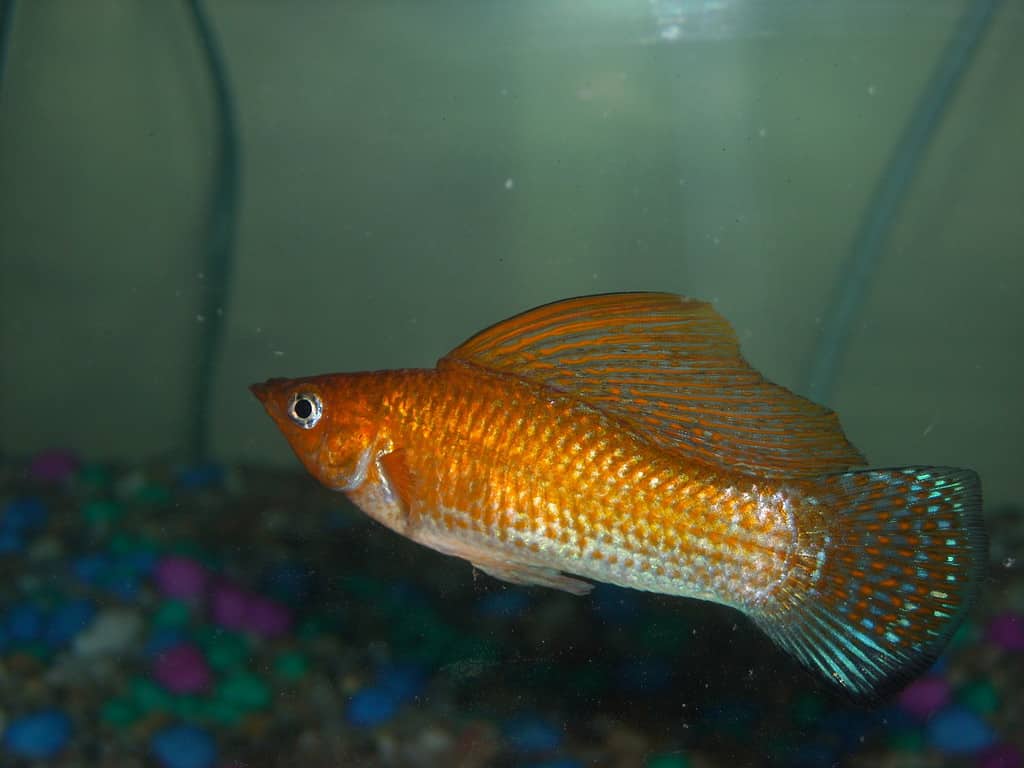
This type of molly is an active swimmer that prefers plenty of open swimming areas within their tank and enjoys being kept in groups for socialization purposes.
©3,264 × 2,448 pixels, file size: 3.5 MB, MIME type: image/jpeg – License
The Yucatan molly fish (Poecilia Velifera) is a species of freshwater aquarium fish native to the southern Gulf Coast of Mexico. It has an elongated, slender body and can grow up to 6 cm in length. Its coloring varies from dark grey-green or brownish tones to bright yellow with black spots on its dorsal fin and tail. The males are generally more colorful than the females, but both genders have beautiful white fins with hints of pink or orange around them. This type of molly is an active swimmer that prefers plenty of open swimming areas within their tank and enjoys being kept in groups for socialization purposes. They do well in tanks with other calm community fish like guppies and platyfish, as long as there is enough room for everyone!
Pacific Molly
The Pacific molly fish (Poecilia Butleri) is a species of tropical live-bearing fish that belongs to the Poeciliidae family. It can be found in freshwater environments in Central America and Mexico, primarily inhabiting slow-moving streams, ponds, and swamps. The Pacific molly is an attractive silver fish with two black lateral stripes running from its gills to the caudal fin. Its dorsal fin has several black spots with yellow edging along its length, while its anal fin also has black spots on each ray.
This species grows up to 2.5 inches in length and prefers slightly acidic water conditions with temperatures ranging from 75–82 °F. In terms of diet, Pacific mollies are omnivorous and mainly consume plant material as well as small invertebrates like insects or worms. They should be kept in aquariums with plenty of hiding places, such as rocks and driftwood, to help them feel safe since they are shy by nature.
Endler’s Livebearer Molly

Endlers are peaceful creatures that typically get along well with other types of tank mates.
©Pavaphon Supanantananont/Shutterstock.com
An Endlers livebearer molly fish, or Poecilia Wingei, is a small and colorful species of freshwater aquarium fish. They are native to certain bodies of water in South America but have been introduced to other areas as well. These fish often reach lengths between 1-2 inches and come in an array of vibrant colors, including yellow, green, black, orange, and blue. Endler’s livebearers are prolific breeders, similar to guppies, and can give birth to up to 30 babies! Endlers are peaceful creatures that typically get along well with other types of tank mates. They should be kept in tanks with plenty of hiding places like caves or plants since they prefer living in groups.
Southern Molly
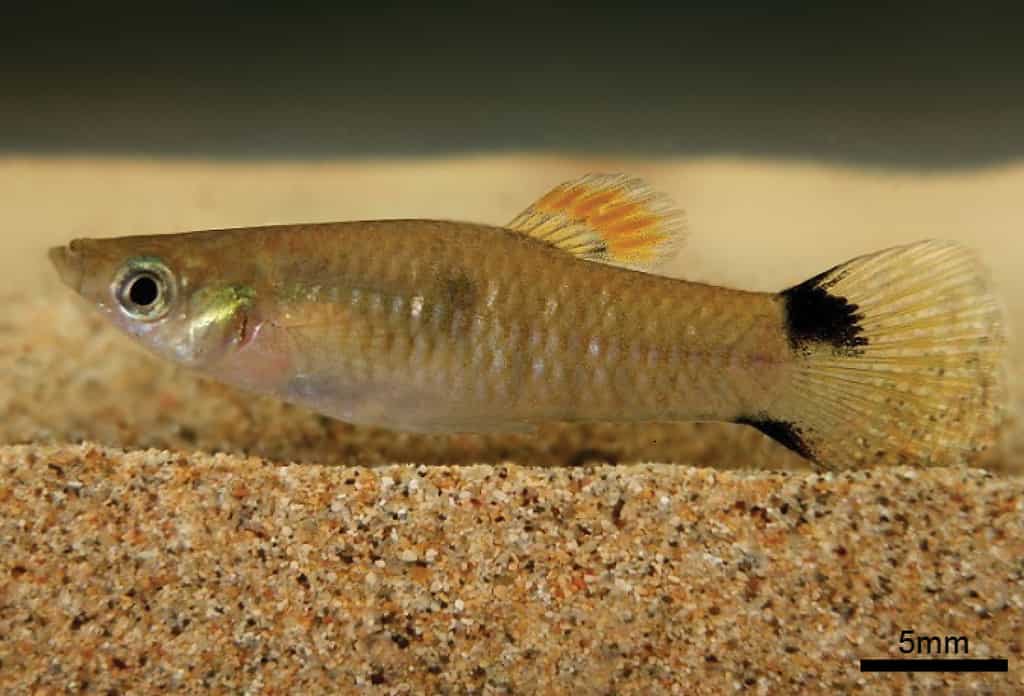
Live male of Poecilia vivipara, UFRN 0225, 25.2 mm SL. Maceió River microbasin, Fernando de Noronha Archipelago, Pernambuco, Brazil.
©https://zookeys.pensoft.net/article/20960/list/2/ (license) – License
Southern molly fish, or Poecilia Vivipara, is a species of livebearer native to Central America. They can be found in large rivers and streams from Mexico down to Panama. Southern mollies have an attractive greenish-brown coloration with black markings on their fins and sides that give them a distinctive look. Their maximum size is about 6 inches, making them suitable for most home aquariums. Southern Mollies are peaceful community fish that prefer water temperatures between 75–82°F. They will eat most types of prepared foods as well as frozen or freeze-dried varieties such as bloodworms, brine shrimp, and daphnia. In addition to eating algae wafers or blanched vegetables like spinach and zucchini, they also love live plants! Southern Mollies are very easy to breed. Females can produce several litters each year, with up to 40 young per litter!
Amazon Molly
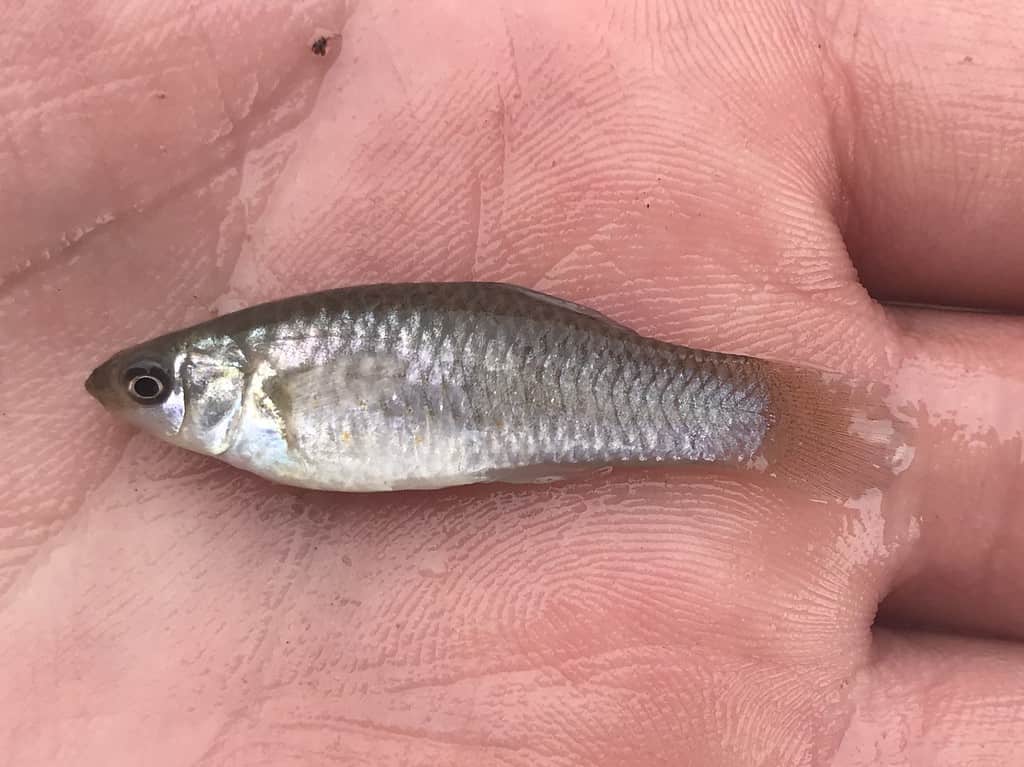
This species has a unique look compared to other mollies with its very long dorsal fin and a pointed tail fin which gives it an elegant appearance when swimming in an aquarium.
©https://www.inaturalist.org/observations/38490435 – License
The Amazon Molly fish, also known as Poecilia Formosa, is an incredibly beautiful and popular freshwater aquarium fish. It originates from the rivers of South America but is now found around the world in many different habitats. This species has a unique look compared to other mollies with its very long dorsal fin and a pointed tail fin which gives it an elegant appearance when swimming in an aquarium. Its body color can vary depending on its surroundings but usually ranges from silver to golden yellow with black stripes along its sides. Additionally, this species tends to be quite peaceful and can easily coexist with other non-aggressive fish like tetras or guppies, making them great starter fish for any new aquarist!
Island Molly
The Island Molly Fish Poecilia Vandepolli is a unique species of live-bearing fish that is native to the freshwater lakes and streams in Central America. It has been selectively bred over many generations for its bright coloration, which ranges from shades of blue, yellow, orange, black, and white. This species can grow up to 4 inches long and has two dorsal fins that are separated by a dark stripe down its back. Island Mollies have an elongated body shape with pronounced scales along the head and sides.
They prefer temperatures between 72°F – 78°F and like to inhabit areas with plenty of vegetation where they can hide or seek refuge when feeling threatened. These fish are omnivorous but tend to favor algae-based foods as well as other small invertebrates, such as planktonic crustaceans. In captivity, they should be fed a variety of high-quality flake food supplemented with fresh fruits/vegetables & frozen bloodworms/brine shrimp occasionally for optimal health & nutrition.
Liberty Molly

Liberty mollies have an olive-green body with yellowish fins that can be quite striking when viewed in the right light.
©1,876 × 1,064 pixels, file size: 624 KB, MIME type: image/jpeg – License
A Liberty molly fish, also known as Poecilia Salvatoris, is a species of freshwater fish native to Eastern Mexico. They are one of the most popular and attractive aquarium fish due to their unique coloring and peaceful nature. Liberty mollies have an olive-green body with yellowish fins that can be quite striking when viewed in the right light. These small-sized fishes grow up to 3 inches long when fully grown and typically live for four years or more if properly cared for. When kept in groups, they form complex social hierarchies making them interesting to watch in home aquariums. Like other Molly species, Liberty mollies require warm water temperatures around 78°F with good filtration and a varied diet consisting mostly of fresh vegetables such as lettuce, zucchini, and spinach, along with commercially available flake food or frozen foods like brine shrimp.
Mangrove Molly

As omnivores, Mangrove mollies will also eat algae and other plant material in addition to these animal proteins.
©https://www.flickr.com/photos/berniedup/49590108878/ – License
The Mangrove molly fish, Poecilia Orri, is a species of fish in the coastal mangroves and estuaries of Central America. They have stocky bodies with an olive-green back and yellowish sides that become even brighter when they breed. The males are usually more colorful than the females and have blue markings around their mouths. These fish prefer living among vegetation where they can hide from predators but will also swim out into open water to feed on small invertebrates such as worms, crustaceans, and plankton. As omnivores, Mangrove mollies will also eat algae and other plant material in addition to these animal proteins. When kept in aquariums, they should be provided with plenty of hiding spots, such as plants or rocks, as well as food specifically designed for omnivorous freshwater fish like flake food or frozen brine shrimp.
Elegant Molly
The elegant molly fish Poecilia Elegans is a type of live-bearing freshwater aquarium fish. It is native to parts of Mexico and Central America, where it is near rivers and streams with slow currents. The elegant molly has an elongated, brightly colored body that comes in many different colors. Some of the most common colors are black, orange, yellow, white, and silver. They typically reach up to 2 inches in length when fully grown. These peaceful omnivores have become popular among aquarists because they are easy to care for and reproduce quickly if provided with clean water conditions. Additionally, their vibrant coloration makes them a great addition to any home or office aquarium setup!
How to Set up Your Aquarium
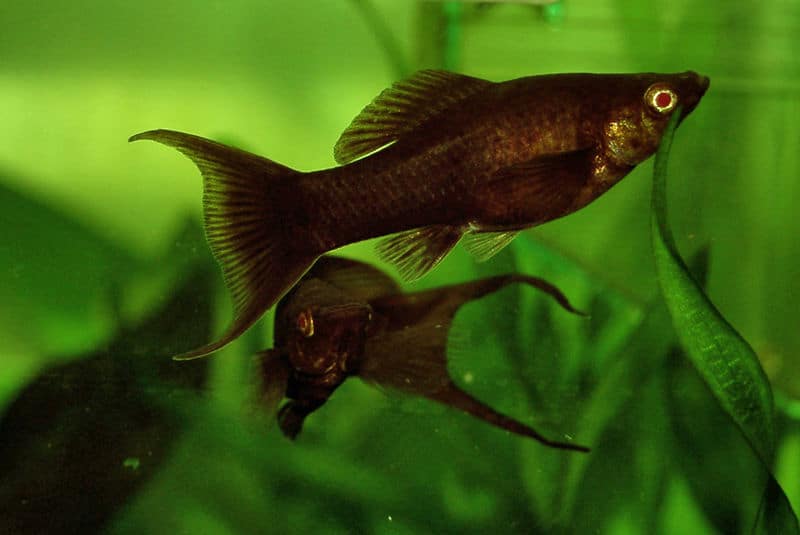
Mollies are a type of freshwater fish that are in a variety of waters, including rivers, tributaries, saline waters, and the open ocean.
©Marrabbio / Creative Commons – License
When setting up an aquarium for molly fish, the tank size should be at least 20 gallons of water, but ideally 29-55 gallons for larger species. Additionally, a heater needs to keep the water temperature around 72-80°F, and the pH, KH, and GH levels should be higher than normal. As mollies tend to reproduce quickly, we suggest having two to three females for every male. Male mollies have a stick-shaped anal fin, and females have a fan-shaped anal fin.
Mollies are a type of freshwater fish that are in a variety of waters, including rivers, tributaries, saline waters, and the open ocean. Despite the misconception that they require salt water to survive, mollies do just fine in freshwater environments. The ideal water temperature is 72-80°F. The pH levels should be between 7.5 to 8.5, depending on the type of molly. Water hardness levels are 20-30KH, ideally.
Environment
Mollies thrive in their natural environment, so you should furnish your aquarium with plants and hiding spots. On the bottom of the tank, use sand or gravel as the base. Mollies prefer to swim in the upper and middle levels of the water, so they won’t be spending much time near the substrate.
Put the substrate in your tank to give live plants a place to grow. It is wise to use a mixture of both taller and shorter plants. Place these around the edge of the aquarium so that there is still some open space for the fish to swim. To finish the decoration, add caves, rocks, or driftwood to provide shelter and food sources for your mollies.
Tank Mates
Mollies are generally peaceful, but they can be active and may nip the fins of slower-moving or long-finned fish. The best tank mates for mollies are other community fish that live in similar environments and are of a similar size. Examples of successful tank mates for mollies include tetras, danios, barbs, loaches, and cory catfish. However, one should avoid putting bigger mollies with smaller creatures like cherry shrimp since they will likely be a snack.
Summary of 13 Types of Molly Fish
| Number | Type |
|---|---|
| 1 | Sailfin Molly |
| 2 | Costa Rican Molly |
| 3 | Short-Fin Molly |
| 4 | Dwarf Molly |
| 5 | Yucatan Molly |
| 6 | Pacific Molly |
| 7 | Endler’s Livebearer |
| 8 | Southern Molly |
| 9 | Amazon Molly |
| 10 | Island Molly |
| 11 | Liberty Molly |
| 12 | Mangrove Molly |
| 13 | Elegant Molly |
The photo featured at the top of this post is © Pantherius/Shutterstock.com
Thank you for reading! Have some feedback for us? Contact the AZ Animals editorial team.







